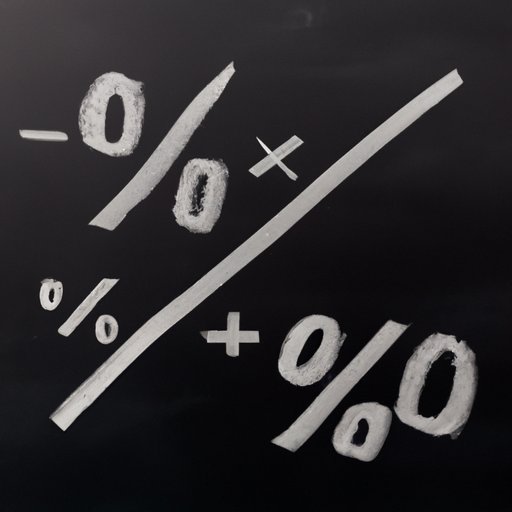
Introduction
Calculating percentages is an essential skill that is used in many aspects of our daily lives, from shopping to budgeting and even in our jobs. It is important to know how to calculate percentages accurately to make informed decisions and avoid costly mistakes. In this article, we will explore the different methods for calculating percentages, including using formulas, proportions, and calculators. We will also provide real-life examples of how to apply this knowledge in everyday situations.
The Formula Method
The formula for calculating percentages involves dividing the value of a part by the value of the whole and multiplying the result by 100. The resulting number is the percentage of the whole that the part represents. This can be expressed as:
Percentage = (Part / Whole) x 100
For example, to find out what percentage of a group of 50 people are male, if 30 people are male, the calculation would be:
Percentage = (30 / 50) x 100 = 60%
It is important to ensure that the part and the whole are referring to the same units, such as dollars or people. Additionally, it is essential to make sure that the decimal point is correctly placed when dividing the part by the whole, and that the answer is multiplied by 100 to obtain a percentage value.
Using Proportions
Proportions can be used to calculate percentages when the part and whole are presented in different ways. The steps involve setting up a proportion and solving for the unknown value. For example, to find out what percentage of a group of 100 people are under 18 years old, if 25 people are under 18, the calculation would be:
25 / 100 = x / 100
Using cross-multiplication, we can solve for x:
x = 25 x 100 / 100 = 25%
Proportions can be a useful alternative to the formula method, especially in situations where the part or the whole are not explicitly given, but can be derived from other information.
The Calculator Method
Using a calculator to find percentages can be an efficient way to save time and avoid mathematical errors. Most calculators have a dedicated key for finding percentages, usually represented by the symbol “%”. The steps involved in using a calculator to find percentages are:
- Enter the value of the whole or the starting point
- Press the percentage key “%”
- Enter the percentage to find or the difference from the starting point
- Press the “=” key to obtain the result
It is important to ensure that the correct percentage value is entered, and to use parentheses when necessary to ensure that the correct order of operations is followed.
Real-Life Applications
Percentages are used in many real-life situations, such as when shopping and calculating discounts or sales tax, and when budgeting for expenses. For example, understanding percentages can help you determine the actual cost savings of a product on sale, or calculate the amount of tax on a purchase. Knowing how to calculate percentages can also help you determine whether you are getting a fair price when comparing prices of similar products with different prices or quantities.
Practical Examples
Here are some practical examples of how to find percentages using the different methods covered in this article:
- To find out what percentage of 80 is 20:
- Formula method: Percentage = (20 / 80) x 100 = 25%
- Proportions method: 20 / 80 = x / 100, x = 20 x 100 / 80 = 25%
- Calculator method: Enter “80”, press the percentage key “%”, enter “20”, press “=”, result: “25”
- To find out what is 20% of 80:
- Formula method: Part = Percentage x Whole / 100 = 20 x 80 / 100 = 16
- Proportions method: N/A
- Calculator method: Enter “80”, press “x” key, enter “20”, press the percentage key “%”, result: “16”
- To find out what percentage of 50 is 10:
- Formula method: Percentage = (10 / 50) x 100 = 20%
- Proportions method: 10 / 50 = x /100, x = 10 x 100 / 50 = 20%
- Calculator method: Enter “50”, press the percentage key “%”, enter “10”, press “=”, result: “20”
- To find out what is 10% less than 50:
- Formula method: N/A
- Proportions method: N/A
- Calculator method: Enter “50”, press the percentage key “%”, enter “10”, press “+/-“, press “=”, result: “45”
When deciding which method to use, it is essential to consider the given problem and the format of the data. While the formula method is straightforward, it requires the part and the whole to be explicitly stated in the problem. The proportions method can be used when the part or the whole can be derived from other information, but it can be time-consuming for simple calculations. The calculator method is ideal for quick and straightforward calculations but may not be as precise as the other methods.
Conclusion
Calculating percentages is a vital skill that can be used in various aspects of our daily lives. Knowing how to find percentages accurately can help us make informed decisions, avoid costly mistakes, and save time. Whether using the formula method, proportions, or calculators, it is essential to consider the given problem and the format of the data when choosing the best method to use. By practicing and applying the methods outlined in this article, readers can improve their percentage calculations skills and make more informed decisions.
Call to action: Now that you have learned the different methods for finding percentages, try applying them in real-life situations. Keep practicing and seeking help when necessary to improve your percentage calculation skills.





